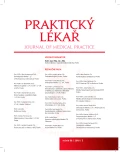Preoperative anaemia: prevalence, causes, consequences, and management
Authors:
J. Slipac
Authors‘ workplace:
EUC Premium s. r. o., Brno
Published in:
Prakt. Lék. 2018; 98(3): 99-103
Category:
Reviews
Overview
Preoperative anaemia is affecting at least a third of patients undergoing elective surgery and is a significant and modifiable risk factor for increased perioperative morbidity and mortality. Iron deficiency is the most common cause of preoperative anaemia and should be corrected. Intravenous iron is efficacious and safe and should be used in patients in whom oral iron is not tolerated or if the time before surgery is short. Erythropoiesis-stimulating agents (ESA) might be suggested (after correction of nutritional deficiencies) for anaemic patients with kidney disease or chronic inflammation and elderly patients with anaemia of unknown cause and adequate iron supply should always be ensured. Elective surgery should be postponed until preoperative anaemia has been appropriately treated. An easy-to-follow algorithm for the detection, evaluation, and appropriate treatment of anaemia and iron deficiency in surgical patients should be used.
Keywords:
preoperative anaemia – iron deficiency – erythropoiesis stimulating agents – algorithm
Sources
1. Beattie WS, Karkouti K, Wijeysundera DN, Tait G. Risk associated with preoperative anemia in noncardiac surgery: a single center cohort study. Anesthesiology 2009; 110(3): 574–581.
2. Ferraris VA, Davenport DL, Saha SP, et al. Surgical outcomes and transfusion of minimal amounts of blood in the operating room. Arch Surg 2012; 147: 49–55.
3. Goodnough LT, Maniatis A, Earnshaw P, et al. Detection, evaluation, and management of preoperative anaemia in the elective orthopaedic surgical patient: NATA guidelines. Br J Anaesth 2011; 106(1): 13–22.
4. Goodnough LT, Nemeth E, Ganz T. Detection, evaluation, and management of iron-restricted erythropoiesis. Blood 2010; 116(23): 4754–4761.
5. Goodnough LT, Schrier SL. Evaluation and management of anemia in the elderly. Am J Hematol 2014; 89(1): 88–96.
6. Guralnik JM, Eisenstaedt RS, Ferrucci L, et al. Prevalence of anemia in persons 65 years and older in the United States: evidence for a high rate of unexplained anemia. Blood 2004; 104: 2263–2268.
7. Kassebaum NJ, Jasrasaria R, Naghavi M, et al. A systematic analysis of global anemia burden from 1990 to 2010. Blood 2014; 123: 615–624.
8. Kotzé A, Harris A, Baker C, et al. British Committee for Standards in Haematology Guidelines on the identification and management of pre-operative anaemia. Br J Haematol 2015; 171: 322–331.
9. Kozek-Langenecker SA, Afshari A, Albaladejo P, et al. Management of severe perioperative bleeding: guidelines from the European Society of Anaesthesiology. Eur J Anaesthesiol 2013; 30: 270–382.
10. Leal-Noval SR, Muñoz M, Asuero M, et al. Spanish consensus statement on alternatives to allogeneic blood transfusion: the 2013 update of the „Seville Document“. Blood Transfus 2013; 11: 585–610.
11. Muñoz M, García-Erce JA, Remacha AF. Disorders of iron metabolism. Part II: iron deficiency and iron overload. J Clin Pathol 2011; 64: 287–296.
12. Muñoz M, Gómez-Ramírez S, Campos A, et al. Pre-operative anaemia: prevalence, consequences and approaches to management. Blood Transfus. 2015; 13(3): 370–379.
13. Muñoz M, Gómez-Ramírez S, Cuenca J, et al. Very-short-term perioperative intravenous iron administration and postoperative outcome in major orthopedic surgery: a pooled analysis of observational data from 2547 patients. Transfusion 2014; 54(2): 289–299.
14. Musallam KM, Tamim HM, Richards T, et al. Preoperative anaemia and postoperative outcomes in non-cardiac surgery: a retrospective cohort study. Lancet 2011; 378: 1396–1407.
15. Parker MJ. Iron supplementation for anemia after hip fracture surgery: a randomized trial of 300 patients. J Bone Joint Surg Am 2010; 92: 265–269.
16. Pasricha SR, Flecknoe-Brown SC, Allen KJ, et al. Diagnosis and management of iron deficiency anaemia: a clinical update. Med J Aust 2010; 193: 525–532.
17. Shander A, Knight K, Thurer R, Adamson J, Spence R. Prevalence and outcomes of anemia in surgery: a systematic review of the literature. Am J Med 2004; 116: 58–69.
18. Shander A, Van Aken H, Colomina MJ, et al. Patient blood management in Europe. Br J Anaesth 2012; 109: 55–68.
19. Society for the Advancement of Blood Management (SABM). Anemia in the pre-surgical patient. Recognition, diagnosis, and management. SABM 2014.
20. Theusinger OM, Kind SL, Seifert B, et al. Patient blood management in orthopaedic surgery – a four year follow up from 2008 to 2011 at the Balgrist University Hospital in Zurich, Switzerland on transfusion requirements and blood loss. Blood Transfus 2014; 12: 195–203.
21. World Health Organization. Haemoglobin concentrations for the diagnosis of anaemia and assessment of severity [online]. Dostupný z: http://apps.who.int/iris/bitstream/10665/85839/3/WHO_NMH_NHD_MNM_11.1_eng.pdf [cit. 2018-01-12]
Labels
General practitioner for children and adolescents General practitioner for adultsArticle was published in
General Practitioner

2018 Issue 3
- Memantine Eases Daily Life for Patients and Caregivers
- Metamizole vs. Tramadol in Postoperative Analgesia
- Metamizole at a Glance and in Practice – Effective Non-Opioid Analgesic for All Ages
- Memantine in Dementia Therapy – Current Findings and Possible Future Applications
- What Effect Can Be Expected from Limosilactobacillus reuteri in Mucositis and Peri-Implantitis?
Most read in this issue
- Preoperative anaemia: prevalence, causes, consequences, and management
- Overview of questionnaires and scales of the motor symptoms of patients with Parkinson’s disease
- Treatment of immunodeficiency by subcutaneous immunoglobulins
- Basics of respiratory physiotherapy for general practitioners
